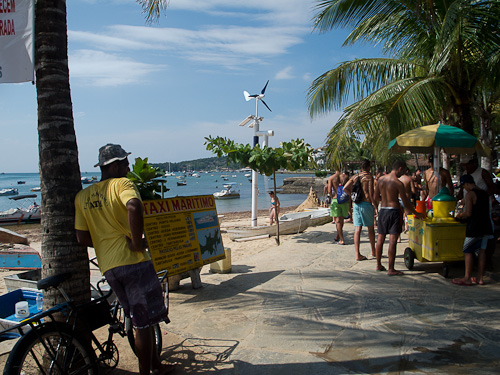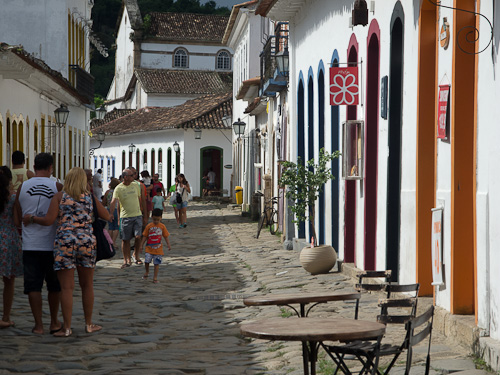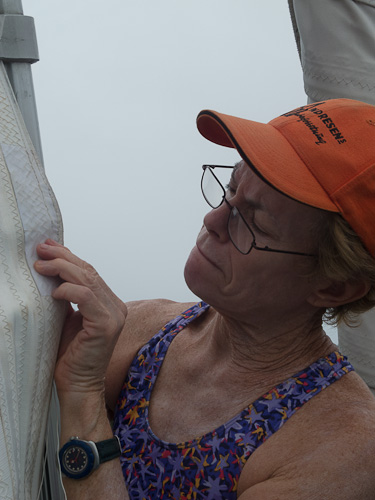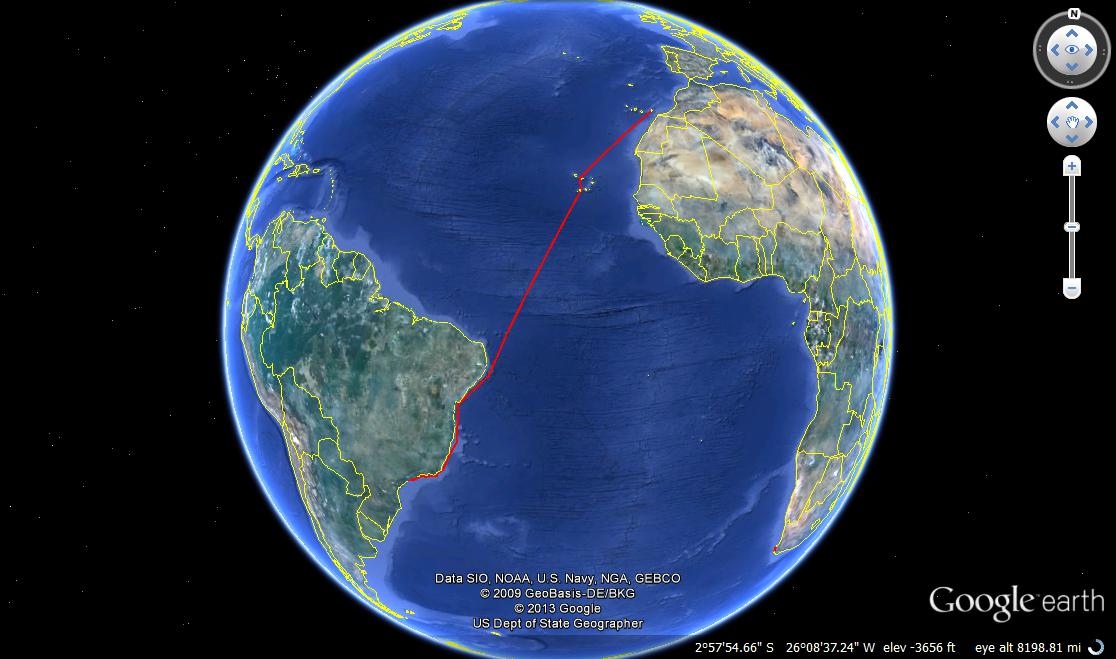|

Beach life is highly developed.

Colonial cobblestoned Paraty is the jewel in Bahia Iha Grande

Everything must be ready for the next ocean crossing

The park ranger was very impressed by Jim's close up of this deadly poisonous snake.

Fishing boats like those that cut in front of us in the night..

Lanzarote to Santos, 4200 miles in two months.
|

|

|

|
March 11th, 2013
Arquipelago dos Abrolhos
17°58’S 38°41.5’W
We arrived at this group of islands (5) Friday morning after an uneventful two day sail from Salvador. After the noise, heat and crowds of the city, this National Park and Marine Reserve overseen by the Brazilian Environmental Agency and the Brazilian Navy, is a small piece of paradise with no other boats. Not long after our anchor was set, we were greeted by a young French intern, Maylese, who told us all the “dos and don’ts”, mostly “don’ts”, of visiting the islands. She offered to take us for a tour of Siriba, the only “approved” island for visiting later in the afternoon and we agreed. The reasons for the restrictions are very apparent once you land on the island. It is a nesting place for masked boobies whose nests are littered throughout the island with one or two eggs inside. The adults showed no fear of us but they were cautious that we didn’t get too close to their offspring. Maylese had also gotten permission for us to see the main island, Santa Barbara, where our military guide, Pacheco, greeted us and with the help of Maylese’s translation, gave us some insight into life on the island where four military families live along with four National Park rangers and frequently some visiting students doing marine biology research. We followed Pacheco up to the hundred year old black and white banded lighthouse and climbed the winding staircase to the top where we had a fabulous 360 degree view of the islands, the ocean and the quickly setting sun – a Kodak moment for sure! After descending, Pacheco gave Jeannie the thrill of throwing the switch and sending the lighthouse beam on its 20 mile sweep. With our tour officially over, we said our thanks, gave Maylese a bottle of French wine and headed back to the boat for dinner and a good night’s sleep.
Our next two days were very laid back with morning chores and afternoons reading, swimming and snorkeling excursions. The crystal clear water was filled with hundreds of colorful fish and various sized brain coral which we explored until our bodies chilled; then back to the boat for a hot shower, a cold drink, dinner and bed by about 9:30. Heaven!
Today we will raise the anchor and leave this lovely place and continue our journey south to Santos. Our next destination is Vitoria, a commercial port 180miles and an overnight sail away. Jim puts in a call to the island authorities and thanks them for letting us stay and share in their little bit of heaven and then we’re off.
Thursday, March 14th, 2013
Vitoria
20°19.5S 40°16.1’W
We spent a couple of warm days in this old commercial port checking out the historic sights which all seem to have a religious theme. Our first stop was the old Palace, founded by the Jesuits in the 1500’s and now occupied by government officials. We climbed the stairs to the Capela Santa Luzia, one of the oldest churches in Brazil, which was packed to the gills with people, priests and even a couple of bishops. We thought maybe this was a serious plea for a Brazilian Pope but more likely, it was a weekday noon- time Mass.
On to the Art Museum, which was closed and then to McDonald’s for something cold to drink. Here we met three lovely young Brazilian ladies having their lunch who offered to give us their unanimous sightseeing recommendation – the Convento da Penha, a fortified monastery built high on a hill above Vila Velha, a neighboring town. “Take a taxi” and we’re glad we did because it is a STEEP hill above Vila Velha and the temperature outside was at least 95 degrees! It is a huge tourist attraction because of the fantastic view you have from the top of the monastery: the sea, all the many container ships at anchor, the city of Vitoria and the surrounding green hills. All this made even more dramatic with lightning flashes from the squalls moving through the area. We descended the steep hill on foot and were amazed at the number of women trudging up the hill with rosaries in their hands. Serious penance indeed!
March 17th, 2013 Luck of the Irish
Buzios
23°8’S 42°W
We arrived in this lovely resort town early this morning after a harrowing overnight passage. Jim described it best in his update to the kids.
“These waters are busy with fishing boats and oil rigs so an exhausting constant watch is in order. The fishing boats are the worst. Their lights do not follow international standards and often show none at all. Furthermore, their wooden vessels make poor radar targets and we rely on radar in busy waters at night. Finally, the moon was just a sliver that set early leaving behind darkness.
I was sleeping at eleven and Nanny was on watch. She was concerned about lights that seemed to be coming at us. She shook me and I woke in a hurry when I realized how close they were. At first I turned on our spreader light illuminating the entire deck and sails, and changed course to starboard, as collision avoidance regulations call for. We were under sail and so had the right of way but this was time to get OUT of the way. I was shocked when the other boat, which should have turned to his starboard and away from us, turned directly at us. Now the side of his forty foot boat was ten feet in front of us and I could see he was towing another boat of the same size. We would just miss him but were making for the tow line and a tee-bone smash with the second boat. I swung the wheel hard to port as the first boat gunned his engine. The second boat swerved away from us and we slipped under his stern, missing it buy several feet.”
Not much sleep for either of us for the rest of the night but now we are safely anchored among the fishing boats and tourist ferries in Buzios’ busy harbor. This used to be a sleepy fishing town until Bridget Bardot came to see the pristine beaches with her boyfriend in the 1960’s. Only three hours from Rio, it is now populated with holiday homes, tee shirt shops and sun seekers. Later on we will head into shore and check out town but now, it’s time for bed.
Sunday, March 24th, 2013
Parati 23°14S 44°38’W
This lovely old cobblestoned city is located in the bay of “Ilha Grande”, the “jewel of the Brazilian coast”. Reportedly, it has 365 anchorages, one for each day of the year. The scenery is stunning: from the purple hills to the lush tropical green of the trees to the white sand beaches, it is a cruiser’s paradise.
After leaving Buzios, we consciously motored past Bahia de Guanabara, where Rio de Janeiro is located. We have visited Rio before and a stop this time would eat up three to four days of the little time we have left before reaching Santos, so we pushed on. The winds were light so we motored and were able to reach Ilha Grande and drop anchor before midnight. Coming into a harbor or an anchorage after dark is always a risky situation with visibility compromised but this was a straight forward approach with no hazards.
The past week has seen us in a different anchorage every night. Our mornings were filled with boat chores e.g. scrubbing the growth off the boat’s bottom and repairing sails; after lunch we’d move to the next destination, go for a swim and settle in for a comfortable night onboard. It’s a peaceful time that we relish as we know the work that awaits us in Santos.
Our time in Parati was brief but we enjoyed coming back to this city that enchanted us seven years ago when we were heading north, up Brazil’s coast. After a walk around town and the nearby fort, threatening clouds called us back to Onora’s open hatches and when the rains came, they filled our water tanks in 15 minutes. Nothing makes Jeannie happier than full water tanks!
Wednesday, March 27, 2013
Santos 24°03’S 46°15.8’W
Before arriving in Santos, we had a few peaceful anchorages to explore. One of the most interesting was Ilha dos Porcos, until the 1970’s, was used as a prison. After the second world war it held Japanese fanatics which had killed Japanese-Brazilians who recognized the end of hostilities. Today the buildings that are in use are for the Park Administration and the scientific center. We shared the beautiful bay with a large red vessel marked “Bombeiro” (Firemen), whose passengers spent the day doing physical training on the beach. Jeannie was very attentive.
We met a young park ranger, Joseph, who gave us the gold medal tour, in Portuguese but with great body language. He pointed out flora and fauna, most notably, the many ‘Capivara’, the world’s largest rodent, that graze on the grass of the empty prison grounds. Jeannie kept her distance.
Another lovely spot to spend the night and then a quick morning swim before we had to move on.
Santos is the biggest port in South America and as we approached the city I counted at least 35 tankers and container ships at anchor awaiting their call for goods. Today with its many high rise buildings, its warm tropical climate and its many sandy beaches, it is one of the major seaside resorts in the state of San Paulo. For us, it is the place where we will prepare Onora for another ocean crossing – this time a 21 day passage to Cape Town, S.A.
Jim’s friend, Ed Bachrach, will join us on Sunday as crew. This will be the first time we have had a crew member on for more than ten days and it will be interesting to see how we all survive our three weeks together. Having a third person on to share watches is a huge help and having someone new to talk with will be enlightening.
Brazil has been a wonderful place to explore on Onora. The country we have seen is beautiful, diverse and friendly. Most people have gone out of their way to help us see the history and beauty of their land – in their cities, on their beaches and in their music and food.
Obrigado and Adeus.
|

|

|

|
|